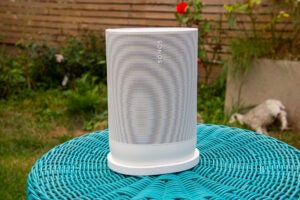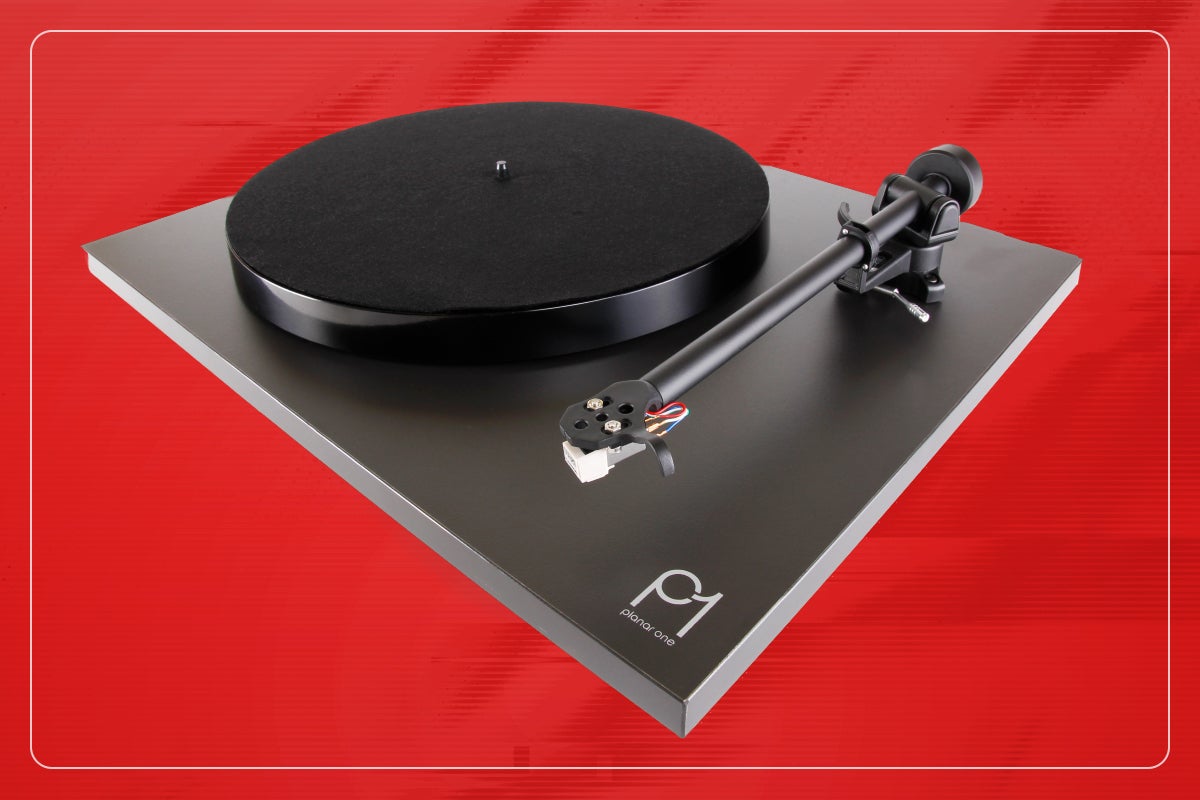Best Sonos Speaker 2024: 5 top choices reviewed and ranked
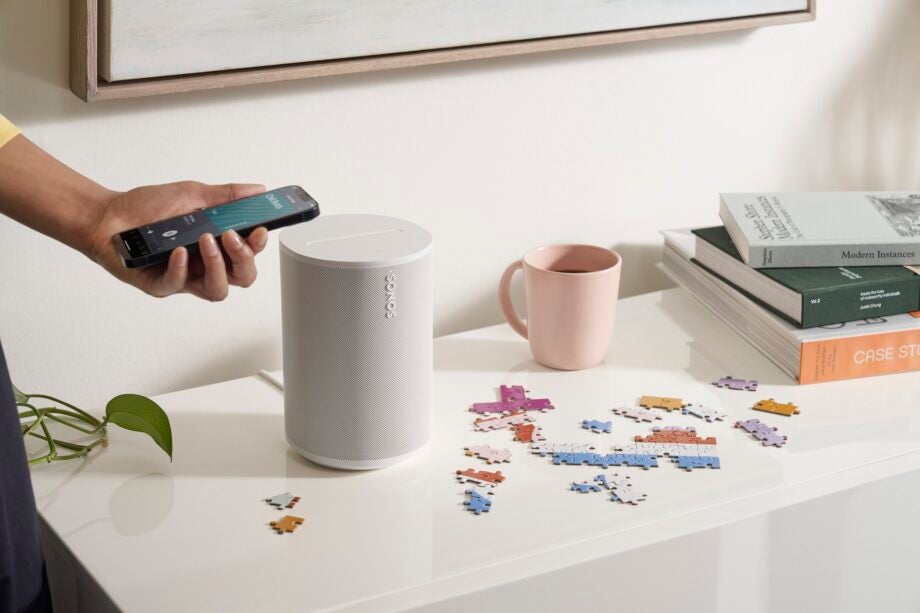
We’ve reviewed all the major speakers released by Sonos, and here you’ll find the definitive ranking of the best.
Sonos products cover a range of use cases, from Bluetooth-enabled portable speakers that can easily be chucked in a bag to room-filling sets with high-end features like spatial audio.
All the speakers included in this list have been fully tested and reviewed by one of our experts. You can always click the review link below the entry to read an in-depth look at the products.
Each product has been tested for sound quality, how good their smart features are and how easy each product is to use, and where possible compared to one another. For a deeper look at the review process for each speaker, see the How we test box below.
If you’ve found this list but want to see what else is out there, we’ve got other best lists to cater for those interests. If it’s portable speakers you’re after then there’s our best outdoor and best Bluetooth speaker lists, while we also have our best smart speaker ranking.
Best Sonos speakers at a glance
- Best portable Sonos speaker: Sonos Roam – check price
- Best compact Sonos speaker for bass: Sonos Era 100 – check price
- Best Sonos Dolby Atmos speaker: Sonos Era 300 – check price
- Best Sonos speaker for privacy: Sonos One SL – check price
- Best Sonos outdoor speaker: Sonos Move 2 – check price
How we test
We play a lot of music, and we play it loud. We play it everywhere – in the house, in the garden, and even in the bath if a speaker is waterproof.
We don’t just listen to the speakers; if there are special features then we make sure we fiddle with them until we’re satisfied. A number of Sonos wireless speakers have smart functionality with the integration of Amazon Alexa, Google Assistant or multi-room, and as a result we start talking to our speakers as well as connecting them together.
Of course, it always comes back to the music. Speakers are tested by reviewers who have a love of music, a knowledge of sound quality, as well as a context of the market. We’ll listen to Bluetooth speakers alongside similarly priced rivals, so when we recommend a particular model, it’s among the best you can buy for the money.
Obviously, we know not everyone has the same taste in music, so we won’t only test with the same perfectly mastered album, but with a variety of genres and file qualities, from MP3 to Hi-Res FLAC.
 Best for portable use
Best for portable use
- Excellent, neutral-sounding performance
- Well built
- New features are useful
- Easy to use
- Auto Trueplay
- Sonos S2 little flaky with new features
- Rather functional looks
- Wireless charging plate an optional extra
 Best compact speaker for bass
Best compact speaker for bass
- More emphatic bass delivery than the One
- Quick Tune Trueplay
- Supports Bluetooth connectivity
- Wider sweet spot
- Excellent app interface
- Hike up in price
- Arguably too bassy
- No adapters included with speaker
 Best for spatial audio
Best for spatial audio
- Expansive Dolby Atmos presentation
- Clear, detailed, and balanced audio
- Quick Tune Trueplay
- Noteworthy looks
- Doesn’t support Atmos playback from Tidal
- Some will find it too expensive
- Adapters are optional extras
- Excellent battery life
- High-quality audio
- Works as a regular Sonos speaker at home
- Expensive
- Line-in adaptor is optional extra

Sonos Roam
Best portable Sonos speaker
Pros
- Excellent, neutral-sounding performance
- Well built
- New features are useful
- Easy to use
- Auto Trueplay
Cons
- Sonos S2 little flaky with new features
- Rather functional looks
- Wireless charging plate an optional extra
If you’re looking to for relatively inexpensive entry point into the world of Sonos, and the Roam series is the most affordable option.
It is a portable speaker shaped like a Toblerone bar that supports both Wi-Fi and Bluetooth connectivity, so it can be used indoors on Wi-Fi and connected to other Sonos speakers, or outdoors with its Bluetooth connection. Another option for a portable speaker is the Sonos Move, which has the same features though its size doesn’t make it as portable as the smaller Roam.
Used indoors it functions like a smart speaker with access to Amazon Alexa and Google Assistant; plus there’s the Sonos app that brings access to a wide range of music streaming services. Neither voice assistance nor the Sonos app can be accessed over a Bluetooth connection, and if you’re not interested in voice control, that’s where the Roam SL comes into play.
Battery life is 11 hours on a single charge, and with an IP67 rating, it’s both dust and water resistant for outdoor usage. Auto Trueplay serves to optimise its audio performance wherever it is and in whichever orientation the speaker is placed in (it can stand vertically or lie down horizontally).
We rated audio quality as excellent for a portable speaker of its size. It goes for a balanced, neutral performance; with vocals clearly relayed and the midrange clear and natural in tone. Treble has bite and detail, and there’s good levels of dynamism, but low frequencies aren’t the best on this speaker. A rival like the Ultimate Ears Boom 2 offers more presence to the bass, and the Roam isn’t as good as the Bang & Olufsen’s Beosound A1 2nd Gen.
There is the Roam SL which has almost everything the Roam above it as, apart from its microphones, which means it does support any voice assistants (which might be useful for privacy reasons). It is also cheaper by about £20 / $20, and comes in more colours too, with black, white, red, green, and blue options available.
Reviewer: Kob Monney
Full Review: Sonos Roam

Sonos Era 300
Best Sonos Dolby Atmos speaker
Pros
- Expansive Dolby Atmos presentation
- Clear, detailed, and balanced audio
- Quick Tune Trueplay
- Noteworthy looks
Cons
- Doesn’t support Atmos playback from Tidal
- Some will find it too expensive
- Adapters are optional extras
Technically, if exclude the soundbars then the Era 300 is Sonos’ first wireless speaker that supports Dolby Atmos. The Era 300 is part of Sonos’ new line of speakers and is much bigger in size than the Era 100, and as a result it’s able to produce a bigger sound courtesy of Atmos spatial audio.
The driver set-up allows the Era 300 to fire audio in front of the speaker, above it and out to the sides for spatial audio tracks. Whereas the Era 100 sounded bassy, the Era 300’s tone has more in common with the One speakers, delivering a crisper, clearer and defter sound. It does take a rather safety first approach to brightness where high frequencies are concerned but its treble performance is crisp and clear.
With Dolby Atmos audio it can sound expansive, producing a sound that’s wider, deeper and taller than the speaker’s dimensions, however this can often depend on how the track was mixed to take advantage of Atmos. You can also edit the height of the performance in the Sonos app if you want a more expansive performance.
Like the Era 100 it doesn’t support Google Assistant but does have the Quick Tune version of Trueplay so it’s a more accessible speaker for Android users. There’s a USB-C port on the rear along with a button that enables Bluetooth pairing and you can turn the microphones completely off if you don’t want voice assistants listening all the time.
The Era 300 supports stereo pairing with another Era 300 or used as a rear Atmos speaker within a Sonos surround sound set-up. And like the Era 100 it can be connected to other external devices or broadband router through an adapter, although disappointingly these are sold separately. Of all the Atmos wireless speakers, the Era 300 ranks as one of the best, and it leaves intrigued as to where the Era series could go next.
Reviewer: Kob Monney
Full Review: Sonos Era 300

Sonos Move 2
Best outdoor Sonos speaker
Pros
- Excellent battery life
- High-quality audio
- Works as a regular Sonos speaker at home
Cons
- Expensive
- Line-in adaptor is optional extra
The Move 2 is Sonos’ biggest portable speaker, although – as with the original – calling it portable is a stretch in light of its size. We’d settle for describing it as an outdoor speaker best suited for areas such as the garden with big groups of people.
Its IP rating isn’t, surprisingly, as strong as the Roam at IP56, but that level of build quality is tough enough to repel water, dust and liquids; though it won’t survive being submerged in water. It’s also what Sonos describes as ‘drop resistant’ so if it falls from a low height it should survive unscathed. Having (wincingly) dropped it a few times on a concrete surface, the Move survived with just a few marks that were able to be brushed off.
It comes in a choice of Shadow Black and Lunar White finishes, both of which protect the speaker from overheating when outside. And just like the Roam, it can switch between Bluetooth and Wi-Fi with the press of a button. On a Wi-Fi connection there’s support for Alexa, Google Assistant and Sonos Voice Control, and you can connect to any other Sonos speaker on the same network to create a multi-room audio set-up.
Auto Trueplay uses the onboard mics to constantly tweak the audio performance with regards to where it is, and since the launch of the Move, Sonos has made sure that it works on both a Wi-Fi and Bluetooth connection. The effect of Auto Trueplay is one we found to be subtle at first, but once it’s up to speed we could hear a slight difference in tone.
Battery is a whopping 24 hours, nearly double what we got on the previous model.
Reviewer: David Ludlow
Full Review: Sonos Move 2
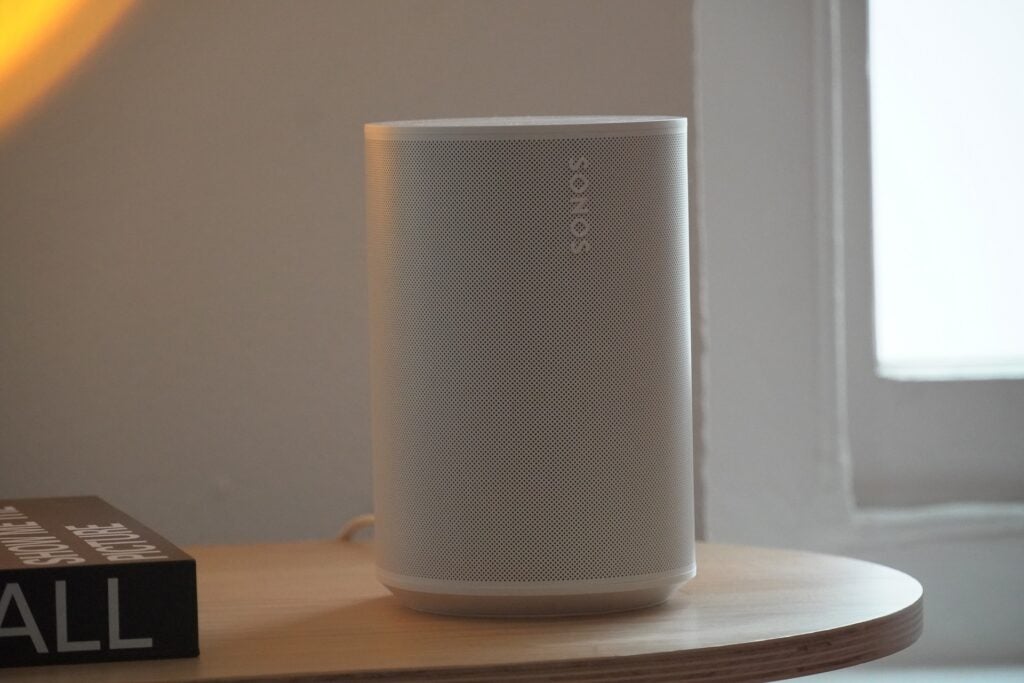
Sonos Era 100
Best compact Sonos speaker for bass
Pros
- More emphatic bass delivery than the One
- Quick Tune Trueplay
- Supports Bluetooth connectivity
- Wider sweet spot
- Excellent app interface
Cons
- Hike up in price
- Arguably too bassy
- No adapters included with speaker
The Era 100 is effectively a replacement for the Sonos One (although that will continue on sale until stock runs out).
It sports a taller, slimmer looking design than the One, and features a new speaker set-up with two angled tweeters to help disperse high frequencies into a room plus a woofer that can provide more bass than the One or One SL models.
We didn’t feel it sounded as clear or detailed in the midrange and high frequencies, the weightiness of the bass affects the tonal balance across the frequency range. The Era 100 provides more power and oomph, though we prefer the One models for their clarity and detail. Bluetooth performance is fine, but the volume does need to be turned up high to get a similar level of quality over a Bluetooth connection.
Other changes from the One models include dropping the Ethernet connection for a USB-C port on the rear, adding Bluetooth playback, and you can choose to turn off the microphones inside the Era 100 via a switch on the back, though this does mean you won’t benefit from either Trueplay tuning or voice assistance.
Amazon Alexa and Sonos Voice Control are supported but Google Assistant is left out. The Era 100 supports a new version of Trueplay that only requires a tap in the Sonos app to begin the process, using the speaker’s built-in microphones to measure its surroundings and optimise the audio output. The Quick Tune version of Trueplay also allows for Android users to be able to use Trueplay.
Finally, the Era 100 is more expensive than the One by $50 / £50, so you’ll want to weigh the bigger bass and more accessible feature set against the One’s more measured and balanced sound.
Reviewer: Kob Monney
Full Review: Sonos Era 100
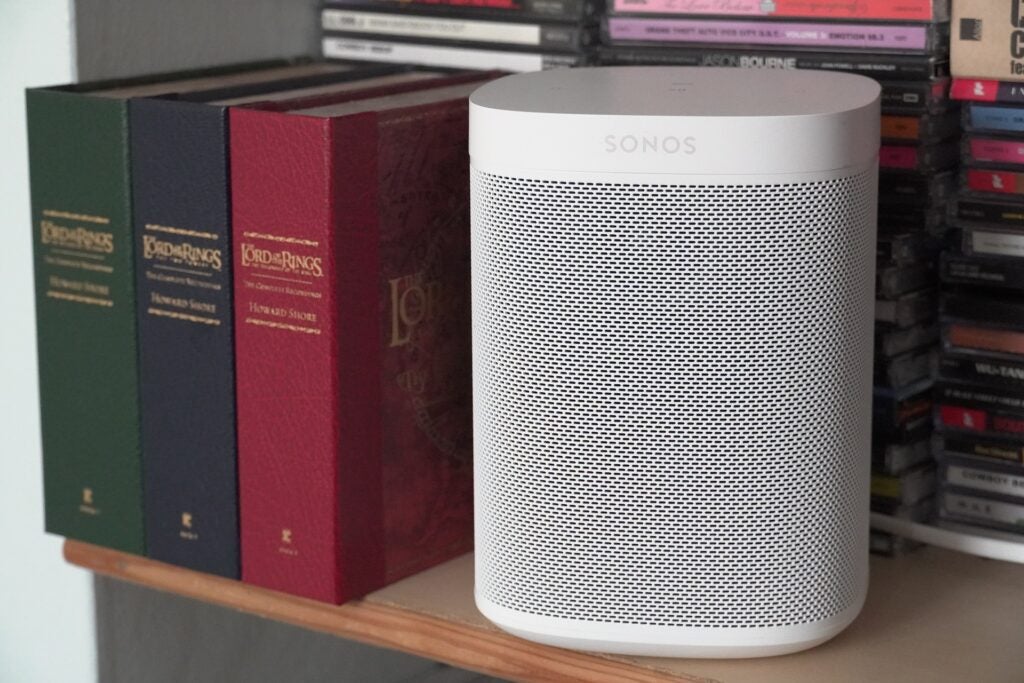
Sonos One SL
Best Sonos speaker for privacy
Pros
- Great sound
- Skips privacy concerns by dropping voice assistants
- Compact size
- Wide integration with music streaming services
Cons
- No Bluetooth
- Requires Trueplay tuning every time its moved
The SL designation for Sonos speakers refers to “speechless”, a reference to the lack of microphones required for voice control. That and a price difference of £20 / $20 are the main differences between the One SL and One, although Trueplay optimisation can still be performed with this speaker if you own an iPhone.
The lack of microphones for smart assistants makes the One SL the better option if you value privacy as the the speaker won’t be listening to you. Otherwise it’s the same as the ‘smarter’ One; its small and compact in size, and suited to being used in a variety of positions whether on a bedside table, bookshelf, desktop or a pair of stands.
It’s also one of the most flexible speakers in the Sonos line-up. If you have a Sonos soundbar you could use a pair of them as surround speakers to fill in the information behind you, or if you purchase another One SL or One you could stereo pair both the speakers. It’s humidity resistant so it can be used in places such as a bathroom, but that’s not to say it is protected against water.
The speaker driver set-up features a single tweeter matched with a woofer to provide the audio and it puts in the type of neutral performance we expect from a Sonos device. The midrange is spacious and detailed, there’s decent weight supplied to the low frequencies (though the Era 100 is better in that respect). It’s not as fun-sounding or warm in tone as the Denon Home 150, but we do find it produces more detail and sounds more balanced.
Reviewer: Kob Monney
Full Review: Sonos One SL
We also considered…
We’ve reviewed
See all reviewsFAQs
The cheapest Sonos speaker is the Roam SL, which is priced at £159 / $159.
Not all Sonos speakers support Bluetooth, but if you are looking for that feature then the portable Roam series and Move speakers support the connectivity standard, as do the Era 100 and Era 300 speakers.


